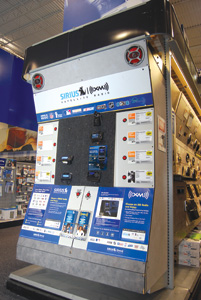Editorial
Front Page - Friday, July 2, 2010
Satellite radio goes next-gen with new devices and content
David Laprad
 Satellite radio giants XM and Sirius merged in 2008 but continue to operate as two separate services. Both offer well over 100 channels of sports, music, comedy and talk for $12.95 per month.
- David Laprad
Satellite radio giants XM and Sirius merged in 2008 but continue to operate as two separate services. Both offer well over 100 channels of sports, music, comedy and talk for $12.95 per month.
- David Laprad
There are two brochures on the satellite radio rack at Best Buy on Gunbarrel Road. One says, “Everything worth listening to is on XM.” The other says, “Everything worth listening to is on Sirius.” So, which one is telling the truth? Actually, they both are.
XM and Sirius, the two giants riding the crest of the subscription radio wave, merged in 2008 but continue to operate as two separate services. While both offer well over 100 channels of sports, music, comedy and talk for $12.95 per month, each one also has content the other one doesn’t. For a few dollars more per month, subscribers can access the best channels from the other service.
James Blake, a member of the Geek Squad at Best Buy and a satellite radio installation specialist, says the merger created a winning scenario for consumers.
“Most of the music is the same on both services, so when you buy a best-of package, you get more sports and talk channels. This works out well, since each service has things the other one doesn’t. Major League Baseball is on XM, for example, while the NFL is on Sirius.”
In addition to being able to tap into a richer vein of content, consumers can also pick and choose what they want to hear. For example, for a few dollars less per month, Sirius subscribers can select channels from an a la carte menu, allowing them to save money by purchasing only the content they want.
The latest devices also offer parental controls, enabling moms and dads to opt out of channels containing content they deem undesirable for their young ones.
Blake says he enjoys the uncensored comedy channels on his XM radio, primarily because he likes to hear classic stand-up routines without the bleeping one hears on a traditional radio station or broadcast television. For him, the appeal of shock jocks like Howard Stern being able to say whatever they want has worn off.
“I prefer uncensored content, but when it gets to the point where a show is more about the hosts saying whatever they can get away with than good radio, I lose interest,” he says.
With increasing competition from iPods and other music players, which allow users to store and listen to thousands of songs wherever they want, including their vehicle, XM and Sirius can’t afford for their customers to begin losing interest. This has pushed satellite radio out of the cars and into the homes and even shirt pockets of its listeners.
Blake, who listens to his XM radio for about four hours a day, owns a Pioneer XMp3i portable satellite radio, which can record up to 100 hours of programming, pause and replay up to 30 minutes of live radio, and store up to 8GB of MP3s
on an optional microSD slot. With devices like this, users no longer have to wait for their favorite song to end before they exit their vehicle.
At $200, the XMp3i might be out of reach for some consumers, so there are less expensive units that play the same channels as their costlier counterparts, just without the bells and whistles. No matter how much a satellite radio unit costs, though, it will be easy to use.
“Most devices have preset buttons, just like a regular radio, so once you figure out which stations you like, you can save them as presets or scroll through them one-by-one. You can also search by category, so if there’s a certain kind of music or sports show you want to hear, you can scan through only the channels that offer that content,” Blake says.
Ease of use extends to installation as well. At Best Buy, customers make an appointment with Blake or another member of the Geek Squad, and in about two hours, have satellite radio up and running in their vehicle.
There are choices to make beyond the purchase of the unit and subscription package, however. Installation at Best Buy ranges from $40 for a barebones setup to $80 for a quality install that hides all of the wires and provides an attractive custom mount.
The equipment that connects the device to the car’s sound system also costs money and can impact on the quality of the audio coming out of the vehicle’s speakers. “A full install with all of the parts will run you about $110 and give you the best sound quality possible. If you run it through your FM radio or auxiliary, it’s going to be static free and sound as good as FM radio or auxiliary can sound.”
For more information, visit xmradio.com or sirius.com. The former include instructions for finding out if a vehicle is XM satellite radio ready, which would enable the user to sign-up online, turn on their radio, and start enjoying, well, everything worth listening to.
|
|